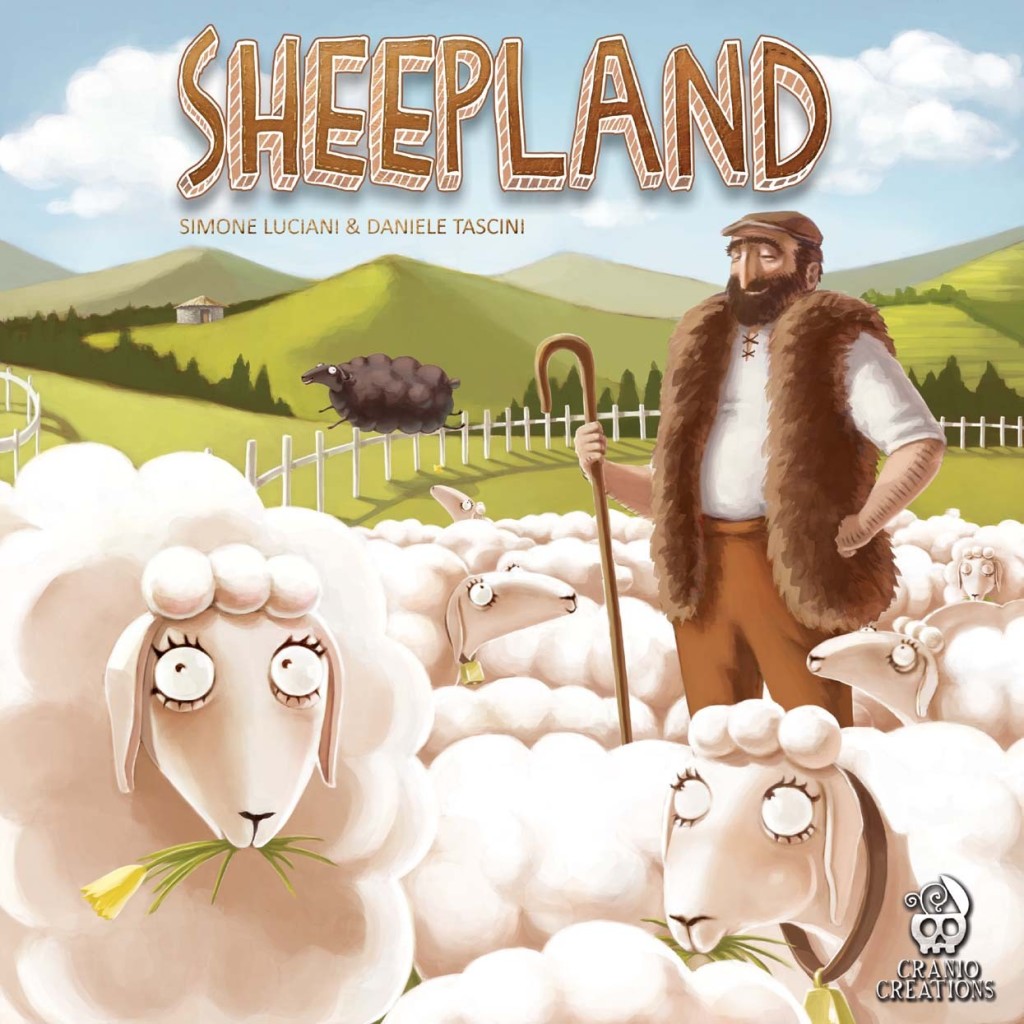Folks couldn’t leave well enough alone. You see, Sheepland was a nice place…full of rolling green meadows, lush forests, and majestic mountains. Don’t worry, it’s not being invaded by orcs, trolls, or anything like that. Rather, someone had the bright idea of putting up fences (probably someone who had stock in Sheepland Timber Company). As a shepherd, you must compete with other shepherds in getting the most profitable lands by herding sheep onto land that you own. Then there’s the black sheep, whose rare black wool is worth a bit more. Will YOU be the richest shepherd in Sheepland?
Components
The game includes 6 starting terrain tiles, 30 terrain tiles, 60 coins, 20 fences, 12 final fences, 1 first player token, 18 white sheep, 1 black sheep, 6 wooden shepherd, and one die.
Setup & Gameplay
Firstly, the black sheep is placed in Sheepsburg while one sheep is placed in each of the remaining eighteen regions. The six starting tiles are shuffled and each player receives one (the rest go back into the box unseen). The terrain tiles are sorted by terrain type in stacks with zeroes on top and fours on the bottom. Each player chooses a color and receives the matching shepherd pawn along with 20 dinars. A first player is chosen and they receive the first player token. Starting with them and going clockwise, players place their shepherd onto any unoccupied numbered road space.
Editor’s Note: In a two player game, each player starts with 30 dinars and uses two shepherd pawns. On each turn, a player chooses one and takes their actions using only that shepherd.
On a player’s turn, they’ll roll the die to see if the black sheep moves. If the rolled number matches an adjacent road space of equal value, it moves to the opposite side of that road. It cannot move onto a space occupied by a fence or shepherd.
After that, the player must take three of the following actions:
1. Move Their Shepherd – A shepherd stays on the numbered road spaces, while sheep sit on the land tiles. Shepherds cannot move to a space already occupied by a fence or player. When a player moves their shepherd to an adjacent unoccupied road space, it’s free. Moving to any other unoccupied space costs one dinar. After moving, the player places a fence on the space they moved from. The final fences are only placed once the regular fences are used.
2. Move 1 Sheep – The player moves any one sheep from either of the regions adjacent to their space to the other region.
3. Buy 1 Terrain Tile – The player pays to bank to buy a terrain tile that matches either of the two regions adjacent to their shepherd.
That player may perform any action in any order, though one of their actions must be to move their shepherd. If the player does perform the same action twice, they must move the shepherd before taking the action a second time.
When all of the regular fences have been placed, the final phase begins and play continues until each player has had an equal number of turns (using the final fences as appropriate). Players calculate the value of each terrain tile they have by counting the number of sheep in those regions across the land. If there is one sheep on a mountain region and two more sheep on another mountain region, then the mountain tile is worth three points. If a player has two mountain tiles, then they’d have six points for that region. The player with the most points once scores are calculated, wins!
Editor’s Note: The above doesn’t cover all of the rules found in the manual, but should give you an idea as to how the game is played.
The Review
I’d classify “Sheepland” as a light strategy game, one focused on predicting which commodity (in this case, land type) will be the most valuable at the end of the game. It’s right up there with “The Settlers of Catan” in the sense that it’s fairly easy to play but still offers players the chance to strategize and think a bit. For example, land tiles of a particular type get more expensive as they are purchased. This mechanic will make picking up tiles in the beginning a no-brainer, though toward the end you’ll most likely pause to consider whether or not spending three/four coin on a particular land type will be worth it in the end. After all, moving your shepherd anywhere on the board for one coin will have its advantages too as fences will block a lot of paths/roads by then.
The components are of good quality and pleasing on the eyes. My only complaint was with the board as it doesn’t tend to lay flat after being unfolded. The theme is family-friendly and the rules not hard to teach, making this game ideal for family game night. The price on Amazon (as of 11/4/15) is just under twenty bucks, meaning it won’t break the bank to buy. All of these things make the game easy to recommend to gamer families, though it could serve as a filler in between longer play sessions. What are you waiting for…go get your “Baa Ram Ewe” on already!
Final Verdict: 8/10
—


